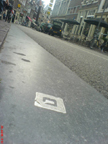Apr 06, 2009
Violet Mirror
The company Violet (best known for the Nabaztag) has invented the "Violet Mirror", a RFID chip reader that can be connected to the PC. The RFID can be attached to any object and scripted to trigger applications and multimedia content automatically or communicate over the Internet.
This is a usage scenario described in the product's website:
"8:40 am – you’re getting ready to leave home. On your desk, next to your computer, a halo of light is quietly pulsating. You swiftly flash your car keys at this mysterious device. A voice speaks out: "today, rain 14°C". The voice continues: "you will get there in 15 minutes". Your computer screen displays an image from the webcam located along the route you’re planning to travel, while the voice reads out your horoscope for the day. At the same moment, your friends can see your social network profile update to "It’s 8:40, I’m leaving the house". At the office, your favourite colleague receives an email to say that you won’t be long. And finally, just as you walk through the door, your computer locks.
You personally "scripted" this morning’s scenario: you decided to give your car keys all these powers, because the time you pick them up signals the fact you’re soon going to leave the house.
What if you could obtain information, access services, communicate with the world, play or have fun just by showing things to a mirror, a Mir:ror which, as if by magic, could make all your everyday objects come alive, and connect them to the Internet’s endless wealth of possibilities?
Mir:ror is as simple to use as looking in the mirror - it gives access to information or triggers actions with disarming ease: simply place an object near to its surface. Mir:ror is a power conferred upon each of us to easily program the most ordinary of objects. The revolution of the Internet of Things suddenly becomes a simple, obvious, daily reality that’s within anyone’s reach."
Watch the video
19:11 Posted in Future interfaces, Wearable & mobile | Permalink | Comments (0) | Tags: internet of things, future interfaces, rfid
Feb 24, 2007
RFID Powder Developed By Hitachi

Hitachi researchers have developed a new micro-miniaturized radio frequency identification (RFID) chip that is 64 times smaller than their currently available 0.4 x 0.4 mm mu-chips.
At 5 microns thick, the RFID chips can more easily be embedded in sheets of paper, meaning they can be used in paper currency, gift certificates and identification
15:23 Posted in Pervasive computing | Permalink | Comments (0) | Tags: rfid, ambient intelligence
Jul 27, 2006
Mediamatic Amsterdam

RFID and The Internet of Things
After a succesfull CrashCourse in May, Mediamatic now presents a second workshop on RFID and The Internet of Things: 11, 12, 13 September 2006 :: Confirmed lecturers and trainers: Julian Bleecker (US), Timo Arnall (Norway) and Arie Altena (NL).
RFID allows for the unique identification of objects, and any kind of online data can be linked to these unique ID's. If RFID becomes an open web-based platform, and users can tag, share, and contribute content to the digital existence of their own places and objects, we can truly speak of an Internet of Things. This opens perpectives for new sustainability scenario's, for new relations between people and the stuff they have, and for other locative applications.
The participants of this workshop will develop critical, utopian or nightmarish concepts for an Internet of Things in a hands-on way. Ideas can range from scripts for small new rituals to outlines of societal changes of epic scale. Prototypes can be tested with the workshop tools The Symbolic Table or the Nokia3220 phone with RFID reader.
The workshop has room for 16 designers, artists, thinkers and makers. Participation fee is 350 per person, ex BTW. Lunches, technical equipment and assistance are included. If you want to participate in this workshop, please register at our online registration form.
12:38 Posted in Positive Technology events | Permalink | Comments (0) | Tags: RFID






